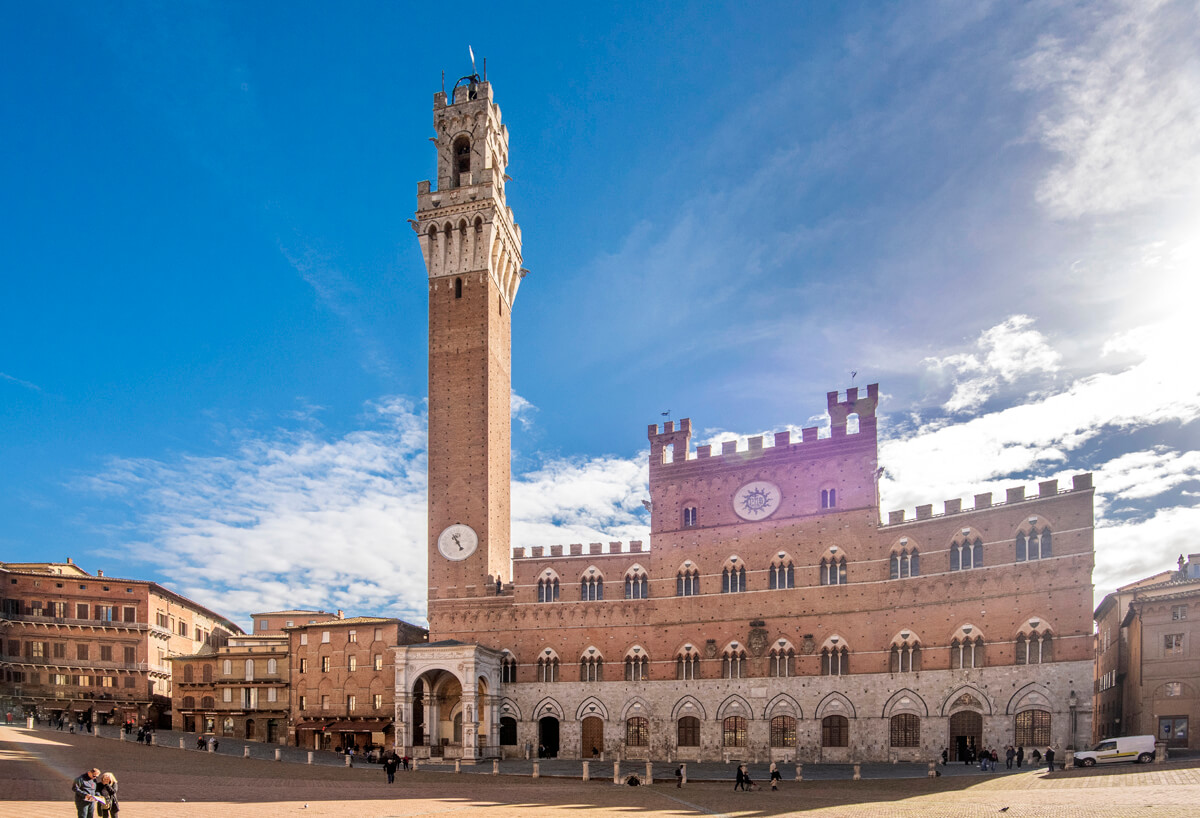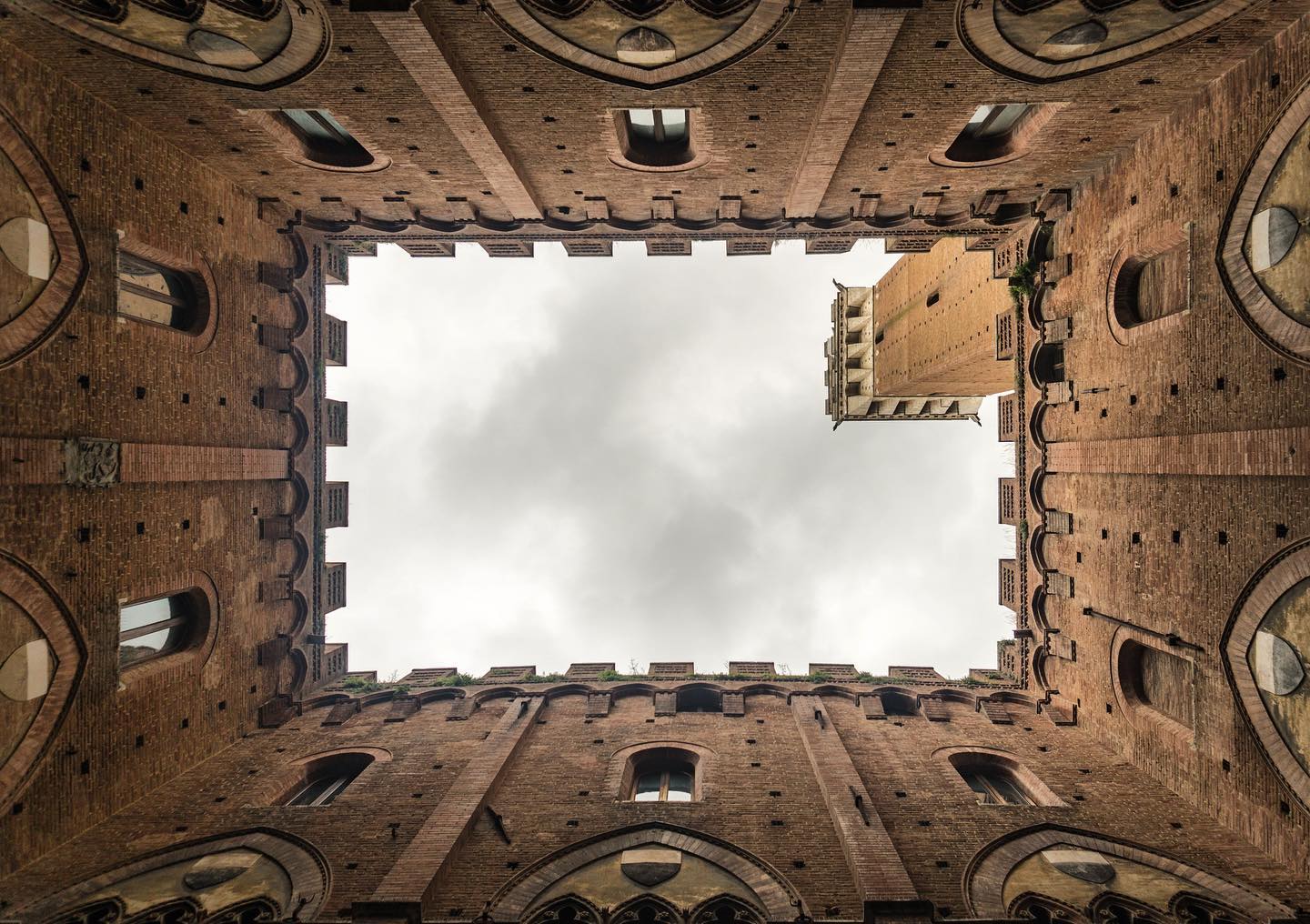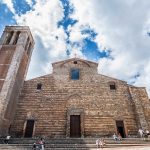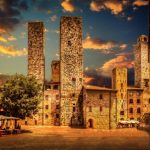The Torre del Mangia is a stunning tower located in Siena, Italy, and is considered one of the most beautiful towers in the country. Built in the 14th century, it stands as a symbol of the city’s rich history and architectural prowess. In this article, we will explore the history, architecture, and cultural significance of this iconic tower.
Torre del Mangia Siena, Italy

📍 A Symbol of Siena’s Rich History: The Torre del Mangia is a historic tower located in Siena, Italy. Built between 1338 and 1348, it stands in the Piazza del Campo, Siena’s main square. The tower was constructed to be the same height as the Siena Cathedral, symbolizing the equal power of the church and the state. The name “Torre del Mangia” refers to its first bellringer, Giovanni di Balduccio, nicknamed Mangiaguadagni. The tower has witnessed many historical events, including the addition of the Cappella di Piazza in 1352 as a vow by Sienese survivors of the Black Death.
📍 An Architectural Masterpiece in Siena: The Torre del Mangia is a stunning example of medieval Italian architecture. Located in Siena’s Piazza del Campo, the tower features distinct levels, including a marble loggia at the base, a long red brick shaft, a stone section that flares out slightly, a short pale-gray upper loggia, and a marble uppermost structure. The Cappella di Piazza, added in 1352, showcases the city’s artistic heritage with sculptures by Mariano d’Angelo Romanelli and Bartolomeo di Tommé. The Torre del Mangia stands as a testament to Siena’s architectural prowess and rich history.
| Feature | Description |
|---|---|
| Location | Siena, Tuscany, Italy |
| Built | 1338-1348 |
| Height | 102 meters (335 feet) |
| Architectural Style | Gothic |
| Main Material | Marble and brick |
| Significance | Symbol of Siena’s history and architectural heritage |
History
The history of the Torre del Mangia is deeply intertwined with the history of Siena itself. The tower was constructed between 1338 and 1348, a period of great prosperity and growth for the city. Siena was a major trade hub and had a strong banking industry, making it one of the wealthiest cities in Italy at the time.
The decision to build the Torre del Mangia in the Piazza del Campo, Siena’s main square, was a deliberate one. The tower was constructed to be the same height as the Siena Cathedral, symbolizing the equal power of the church and the state. This was a bold statement of Siena’s civic pride and independence during a time when the church held significant political and religious influence. The name “Torre del Mangia” has an interesting origin. It refers to its first bellringer, Giovanni di Balduccio, who was nicknamed Mangiaguadagni, which translates to “Profit eater.” This nickname was given to him either due to his spendthrift tendencies, idleness, or gluttony.
The tower has witnessed many historical events throughout the centuries. In 1352, the Cappella di Piazza was added to the base of the tower as a fulfillment of a vow made by the Sienese survivors of the Black Death. This devastating plague had a profound impact on the city and its population. The Torre del Mangia has stood as a silent witness to the rise and fall of empires, the ebb and flow of trade, and the changing fortunes of Siena. Today, it remains a symbol of the city’s rich history and a testament to the architectural and artistic achievements of the medieval period.
FAQs

Find answers to frequently asked questions about the Torre del Mangia.
1. How long does it take to climb Torre del Mangia?
- Climbing the Torre del Mangia should take no more than 10 minutes, but it can be done much quicker. Just go at your own pace and be considerate of others who may be struggling. There is no lift, and the tower is not wheelchair accessible.
2. How many steps are there in the Torre del Mangia?
- There are 400 steps to reach the top of the Torre del Mangia.
3. What is the tallest building in Siena, Italy?
- The Torre del Mangia is the tallest building in Siena, Italy. It was built to rival the tallest tower in Florence and was the tallest tower of its time with a height of 88 meters. Currently, it is the third tallest tower in all of Italy.
4. How old is Siena’s tower?
- The Torre del Mangia in Siena was built between 1338 and 1348, making it over 670 years old.
5. When was Torre del Mangia built?
- The Torre del Mangia was built between 1338 and 1348.
Torre del Mangia Siena, Italy: Tickets & Tourist Information

📍Learn how to visit the Torre del Mangia, including opening hours and ticket information.he Torre del Mangia is one of Siena’s most iconic landmarks, offering breathtaking views of the city. Located in the Piazza del Campo, the tower is open to visitors during specific hours, with tickets starting at €10.00. The visit lasts a maximum of 30 minutes and involves climbing about 400 steps. Please note that the tower has a maximum daily capacity, and ticket sales end once it is reached. For more information, contact 0577-292614/15 or email [email protected].
| Information | Details |
|---|---|
| Opening Hours | Nov-Feb: 10:00-13:00 / 13:45-16:00 Mar-Oct: 10:00-13:45 / 14:30-19:00 Special hours during the Palio |
| Ticket Prices | Standard: €10.00 Family: €25.00 Free: Residents of Siena, children under 11 |
| Cumulative Tickets | Museo Civico + Torre del Mangia: €15.00 Museo Civico + Santa Maria della Scala + Torre del Mangia: €20.00 Family: €40.00 |
| Integrated Tickets | Museo Civico + Santa Maria della Scala + Torre del Mangia + Pinacoteca Nazionale di Siena: €24.00 |
| Contact | Phone: 0577-292614/15 Email: [email protected] |
| Visit Duration | Maximum 30 minutes (ascent, stop, descent) |
| Restrictions | Not suitable for people with health issues, pregnant women, unaccompanied minors under 14 |
| Safety Measures | No animals allowed, limited use of cameras and camcorders, mandatory deposit of objects and bags |
The Torre del Mangia is one of the most iconic landmarks in Siena, Italy. If you’re planning to visit this historic tower, here’s what you need to know:
Opening Hours:
- From November 1 to February 28: 10:00 AM – 1:00 PM / 1:45 PM – 4:00 PM (ticket office closes and last entry at 3:15 PM)
- Christmas Day: Closed
- New Year’s Day: 12:00 PM – 4:00 PM (ticket office closes and last entry at 3:15 PM)
- From March 1 to October 31: 10:00 AM – 1:45 PM / 2:30 PM – 7:00 PM (ticket office closes and last entry at 6:15 PM)
Special Hours for Palio on August 16, 2023:
- August 10: Tower closes at 6:30 PM (ticket office closes at 5:45 PM)
- August 13: Tower closed to the public
- August 14: Tower open from 10:00 AM to 3:30 PM (ticket office closes at 2:45 PM)
- August 15: Tower open from 10:00 AM to 2:30 PM (ticket office closes at 1:45 PM)
- August 16: Tower open from 10:00 AM to 1:00 PM (ticket office closes at 12:15 PM)
Tickets:
- Standard: €10.00
- Family: €25.00 (2 adults + children over 11 years old)
- Free: Residents of Siena, children under 11 years old
Cumulative Tickets (valid for 2 days):
- Museo Civico + Torre del Mangia: €15.00
- Museo Civico + Santa Maria della Scala + Torre del Mangia: €20.00
- Family (2 adults + children over 11 years old): €40.00
Integrated Tickets:
- Museo Civico + Santa Maria della Scala + Torre del Mangia + Pinacoteca Nazionale di Siena: €24.00
Tickets for the Torre del Mangia are not available for reservation and can only be purchased at the ticket offices of the Museo Civico and Santa Maria della Scala on the day of the visit. In the case of cumulative or integrated tickets, the first entry must be made at the Torre del Mangia.
Contact:
- Phone: 0577-292614/15
- Email: [email protected]
Visitor Information:
The visit is allowed for a maximum duration of 30 minutes (ascent, stop, descent). The tower has a maximum daily capacity, and ticket sales end when it is reached. The tower will be closed in case of bad weather, restoration, and maintenance. It is not equipped with an elevator. Access to the top requires climbing about 400 steps, so the visit is strongly discouraged for people with heart disease, respiratory diseases, claustrophobia, vertigo, diabetes, pregnant women, and generally those who are not in good health. Minors under 14 years old can only access if accompanied by adults.
Safety Measures:
For the safety of visitors and to prevent accidental falling of objects from the top of the tower:
- Animals are not allowed.
- The use of cameras and camcorders without accessories (supplementary lenses, cases, tripods, selfie sticks, etc.) is allowed. All other objects, bags, and/or containers must be left at the collection point in special lockers located on the first level of the tower. Upon request from the staff, visitors may be subjected to a check.
- A video surveillance device is active along the entire route. Any act contrary to safety principles and heritage protection will be prosecuted according to the law.
Ticket: https://www.comune.siena.it/node/509
What is the most beautiful tower in Italy?
Italy is home to some of the most beautiful and iconic towers in the world. Among them, the Leaning Tower of Pisa stands out for its unique tilt and architectural beauty. Another remarkable tower is the Torre del Mangia in Siena, known for its stunning views and historical significance. These towers, along with others like the Asinelli Tower in Bologna and the Bell Tower of St. Mark’s Basilica in Venice, showcase the rich architectural heritage of Italy.
The Leaning Tower of Pisa is undoubtedly one of the most famous towers in Italy and the world. Its unintended tilt has made it a symbol of architectural uniqueness and a must-visit landmark. However, Italy boasts other remarkable towers, such as the Torre del Mangia in Siena, which offers breathtaking views of the city and the Tuscan countryside. These towers represent the architectural diversity and historical richness of Italy, making them essential stops for any traveler.
Architecture
The architecture of the Torre del Mangia is a remarkable example of medieval Italian design. The tower is characterized by its visually distinct levels, each contributing to its unique appearance. The base of the tower features a marble loggia, followed by a long red brick shaft that gives the tower its height and slender appearance. Above the brick shaft, there is a stone section that flares out slightly, adding a sense of stability to the structure.
The tower is crowned with a short pale-gray upper loggia and a marble uppermost structure. The combination of materials, including marble and brick, showcases the architectural diversity of the period and adds to the tower’s aesthetic appeal.
The Cappella di Piazza, added to the tower in 1352, is another architectural highlight. This loggia, where the tower meets the Piazza del Campo, was built in fulfillment of a vow to the Holy Virgin by Sienese survivors of the Black Death. The corner pilasters of the loggia attained their current form in 1378, adorned with sculptures executed by Mariano d’Angelo Romanelli e Bartolomeo di Tommé. The simple wooden ceiling of the loggia was later replaced by a Renaissance marble vault, adding to the tower’s architectural complexity.
The Torre del Mangia’s architecture is not only a reflection of Siena’s history and culture but also a testament to the city’s architectural prowess during the medieval period.
Cappella di Piazza
The Cappella di Piazza, also known as the Chapel of the Square, is an integral part of the Torre del Mangia’s architectural ensemble. This loggia, situated at the base of the tower where it meets the Piazza del Campo, was added in 1352. It was constructed as a fulfillment of a vow made by the Sienese survivors of the Black Death, a devastating plague that swept through Europe in the 14th century.
The Cappella di Piazza is characterized by its corner pilasters, which were given their current form in 1378. These pilasters are adorned with sculptures that were executed between 1378 and 1382 by the renowned artists Mariano d’Angelo Romanelli and Bartolomeo di Tommé. The sculptures add a layer of artistic richness to the chapel and enhance its visual appeal.
Originally, the loggia of the Cappella di Piazza was covered with a simple wooden ceiling. However, this was replaced by a Renaissance marble vault between 1461 and 1468. The marble vault was designed by Antonio Federighi, who was also responsible for the unique decorations of the coronation. In the years 1537-1539, the artist Il Sodoma painted a fresco above the altar of the chapel, which is now housed in the town museum in the Palazzo Pubblico.
The Cappella di Piazza stands as a testament to Siena’s resilience in the face of adversity and its dedication to the Holy Virgin. It also showcases the city’s rich artistic and architectural heritage, which continues to captivate visitors to this day.
4. Clock and Bells
The clock on the lower part of the shaft was added in 1360. The tower houses three bells, the largest of which, the “Sunto,” plays a significant role in the Palio celebrations.
5. Structural Features
The walls of the tower are approximately 3 meters (9.8 feet) thick on each side, showcasing the robust construction of the tower.
6. Cultural Influence
The Torre del Mangia has inspired several towers worldwide, including the Joseph Chamberlain Memorial Clock Tower in the UK and the Pilgrim Monument in Massachusetts, USA.
7. Fun Facts
Discover interesting facts and unique details about the Torre del Mangia.



